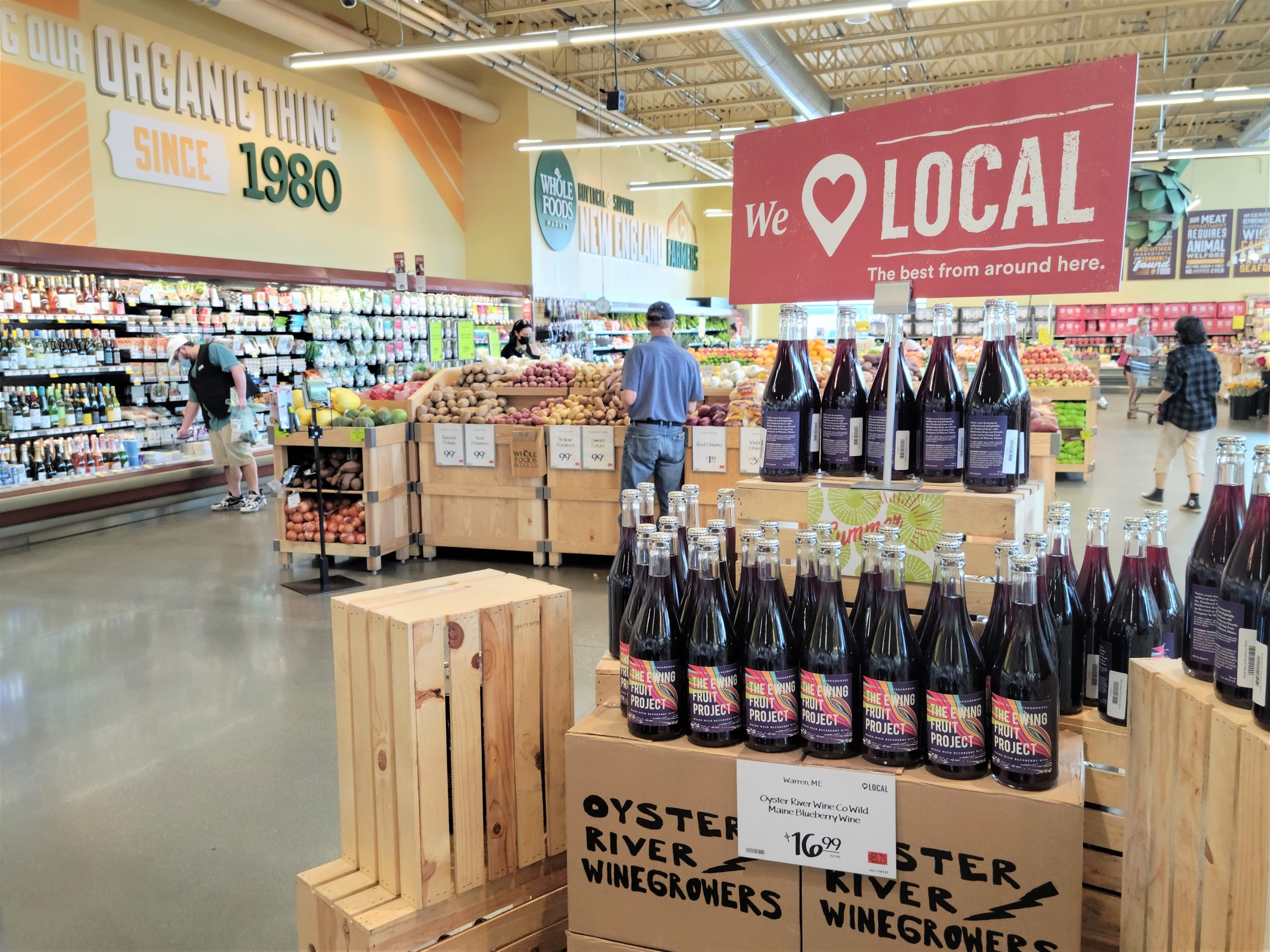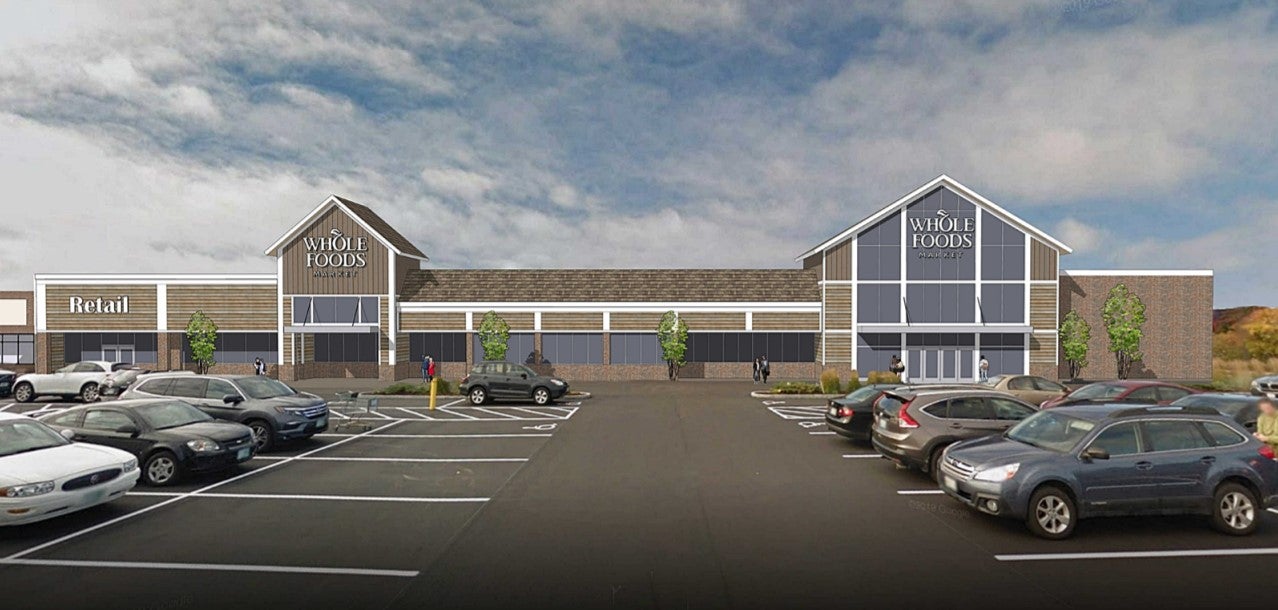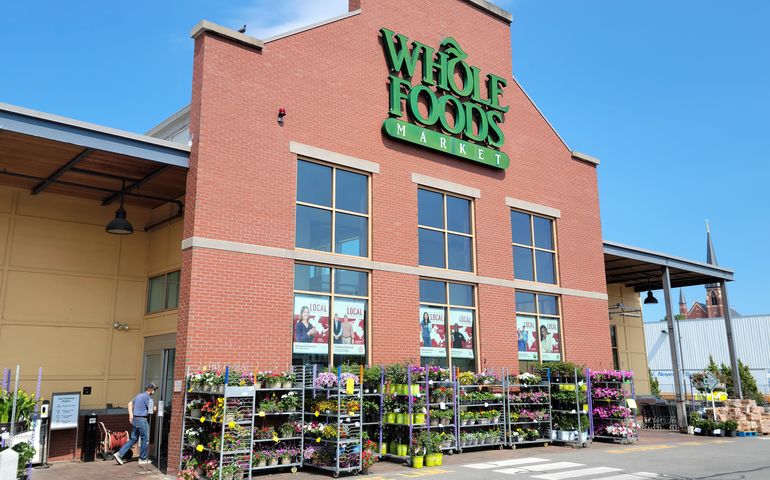A new Whole Foods Market store will soon be serving grocery shoppers from southern Maine, and could also serve a boost to southern Maine real estate.
But the 42,000-square-foot supermarket, expected to open in June, is across the Piscataqua River from Maine, where a Portland store is the lone Whole Foods outpost.
The Portsmouth, N.H., store will be the third Whole Foods has launched in that state since 2014.
The upscale organic and natural foods retailer, acquired by Amazon.com (Nasdaq: AMZN) in 2017 for $13.7 billion, now has over 530 stores in the U.S., Canada and the United Kingdom. For the past two years — even during the pandemic — Whole Foods has been adding stores at a rate of more than one a month.
The Portland store dates to 2007. A second location was rumored for Scarborough soon afterward, but never materialized.
Meanwhile, the stores themselves are sought after as much as their red velvet French macarons.
People from Grand Rapids, Mich., to Cary, N.C., to Westerly, R.I., have launched petitions on Change.org asking Whole Foods to move into their neighborhoods.
In Berks County, Pa., over 400 residents joined an email campaign and launched a Facebook page attempting to attract a store.
Whole Foods opened one of its six Washington, D.C., markets partly because “the community asked us to come there and wanted that store,” Regional President Scott Allhouse told the Washington Post in 2013. “Every day we get requests for stores all over the country.”
No wonder a snarky comment became popular on Reddit and Twitter a few years ago: “There’s no Whole Foods in New Haven. Where the eff am I going to find soy green tea ice cream next year when I go to Yale?”
Whole Foods, headquartered in Austin, Texas, still has no store in New Haven, and the nearest one is 15 miles away.
Perhaps there’s good reason for the mania over these markets.
A 2017 study by real estate website Zillow found that U.S. homes near a Whole Foods store appreciated an average of 140% over a 17-year period, twice the average nationwide. And the dates of the booms showed that the stores weren’t simply leveraging already-hot neighborhoods, Zillow noted.
Another study, in 2007, found a similar correlation. The trend has even been dubbed “the Whole Foods effect,” which some critics have said contributes to gentrification of urban neighborhoods.
The right fit
In Portsmouth, fit-out of the store is nearly complete, and hiring ads seek workers who can start in June. A Whole Foods spokesman refused to say exactly when the store is opening, or to provide other details for this article.
The store is a former Shaw’s supermarket that closed in February 2019 after doing business for 26 years. It anchors the Durgin Square Shopping Center, a 135,000-square-foot property acquired for $24.7 million in 2014 by a Denver-based real estate investment firm, Black Creek Group, according to tax records. Black Creek announced in April 2020 that it had signed Whole Foods as a tenant; terms were not disclosed.
The shopping center is one of several along Woodbury Avenue in Portsmouth. There’s a Market Basket grocery story across the street and an Aldi supermarket half a mile away. Scarborough-based Hannaford Supermarkets has a store 2 miles away.
From siting to size, the new store will be different from the one in Portland, and the contrast says something about Whole Foods Market’s new place in the marketplace.
The 14-year-old store in Portland’s Bayside neighborhood has a larger footprint, 56,000 square feet. With a crowded mix of housing and aging industrial real estate nearby, the setting is more urban than Woodbury Avenue.
Unlike the Portsmouth store, the Portland one was new construction. Whole Foods built on Somerset Street shortly after buying out a local organic food store, the Whole Grocer, and acquiring a national chain of natural food stores, Wild Oats Market, including its Portland store.
Whole Foods operated out of the Wild Oats space, nearby on Marginal Way, during 2006 while the new store was under construction. Today, the space is home to a Whole Foods competitor, another national chain with a strong presence in the natural foods sector, Trader Joe’s.
Some people credit Whole Foods with spurring the growth of that sector in Maine.
Whole Grocer’s owner, Chandrika Sanyal, told Mainebiz at the time, “As a standalone store we’ve done what we could with all the resources we had. We have been very successful. But with Whole Foods approaching us, it became clear that we have become part of a big, huge family where the resources have doubled and tripled for us.”
Dan Porta, who since 1993 has owned Lois’ Natural Marketplace in Scarborough with his wife, Lois, saw the entry of Whole Foods as a potential benefit.
“A rising tide raises all boats,” he told Mainebiz in an interview last week. “This was an upshift in the way people started thinking about food. And we thought it was fantastic that, despite the competition, Whole Foods would choose Portland, Maine. At a philosophical level we were just glad to see more organic products on the market.”
Around the same time, Hannaford — which has a store on Forest Avenue, a short walk from Whole Foods — began stepping up its own natural foods game. In 2007, the chain became certified by Quality Assurance International, the same organization that certified the organic offerings of Whole Foods. Hannaford also launched a private-label line of natural products.
Sizing up the competition
While Whole Foods may have helped bring organic groceries into the mainstream, the company itself has now become the mainstream, some grocers say. And the Portsmouth store’s competition may be other big chains instead of small specialty food merchants.
The new store is likely to draw customers from Kittery and Eliot, where there are no major supermarkets and where residents are already used to making a quick trip across the river to shop.
Porta has mixed opinions about whether or not Whole Foods will threaten Maine businesses. “It’ll have some impact on natural food stores in southern Maine, and I might get concerned if they opened across the street,” he said. “But each store has a different mission.”

Especially since the acquisition, Whole Foods is on a different playing field. At Lois’ Natural, he said, “at this point, we could never approach what Amazon does.”
The growth of Whole Foods may be diluting its commitment to fresh, local foods, Porta feels. “It’s like, who’s delivering your food, Main Street or Wall Street?” he said.
At Golden Harvest and Carl’s Meat Market, a pair of fresh-food stores in Kittery that are decades old, owner Jim Spencer expressed similar ambivalence.
“We’re not excited [about the Portsmouth store],” he told Mainebiz. “We’ve been around a while, and we’ll probably see an impact for a couple of weeks. They’re competition but they’re also in a different category. And at the end of the day, they’re just another big grocery store.”
Hannaford, which operates over 180 stores in the Northeast including the one in Portsmouth and one nearby in York, is also nonplussed.
Spokesman Eric Blom told Mainebiz, “We welcome competition and have it in every market. Competition makes all retailers better.”
Demographics
As for Whole Foods, the company wouldn’t say anything about potential competition. Nor would Whole Foods comment on its location strategy or prospects for another store in Maine. The company’s list of stores in development doesn’t include one.
But the list is out of date. (Some of the stores shown opened last year.) And Whole Foods does provide some general guidelines for potential store sites. (See sidebar.) High on the demographic wish list: a population of 200,000, largely college-educated, within a 20-minute drive.
The demographics don’t appear to be deal-breakers. One of the newest Whole Foods stores, which opened April 22, is in Jackson, Wyo., a resort town whose surrounding population totals only 70,000 at the height of the tourism season. To find 200,000 people, you’d have to go pretty far — that number is more than a third of the entire population in Wyoming, which has fewer people per square mile than any state but Alaska.
For a company that touts its locally sourced products, such a small pool of customers seems to make sense. But in other states, the allotment of Whole Foods stores seems lopsided.
For example, Massachusetts is home to 33 of the markets, or one for every 208,879 residents. In another affluent, educated New England state, Connecticut, there are only nine stores and almost twice as many residents per location. Rhode Island has three stores, or one per 353,000 residents.
In Vermont, where the company promotes home-grown products by listing five “favorite local Vermont partners” on its website, the number of Whole Foods Market branches is zero.
In the 2013 Washington Post report, Whole Foods acknowledged that many factors go into decisions about where to open a new store. “We have a process,” Allhouse said. It’s not just a matter of numbers, and also hinges on criteria such as real estate availability.
Other numbers suggest Mainers and grocery customers in general are doing just fine even if there isn’t a Whole Foods in their town.
Online grocery shopping has skyrocketed during the pandemic, and it looks as if the trend is here to stay. A market study reported in March by Supermarket News forecast that American consumers will spend $250 billion in online grocery purchases by 2025, representing 22% of all grocery buying and up from $106 billion in 2020.
Whole Foods, of course, contributed to the online boom before the pandemic through the Amazon Prime e-grocery shopping service. Now, the trend could be catching up with the very brick-and-mortar stores that created the Whole Foods mystique.
On May 13, the company announced a restructuring in some of its corporate departments, and was notifying “impacted” members of its 105,000-person workforce. The changes come after Amazon recently reported a continued decline in physical store sales for the first quarter of this year.
While online business has boomed, Amazon’s brick-and-mortar revenues — which consist almost entirely of Whole Foods sales — fell 15.5% to $3.92 billion. That decrease followed an 8% year-over-year drop in the fourth quarter of 2020. In fiscal 2020, Amazon recorded store sales declines in three out of four quarters.

